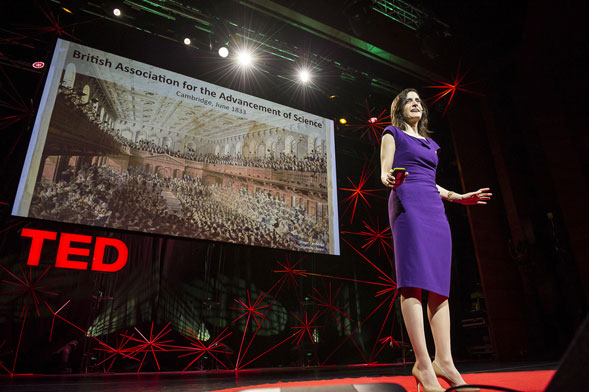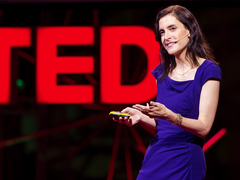
Photo: James Duncan Davidson
In 1812, four men met for a “philosophical breakfast” at Cambridge University: Charles Babbage, John Herschel, Richard Jones and William Whewell. Over food and drinks, they debated the state of knowledge –- imagining a world in which thinkers drew conclusions based on data, where research was done for the good of humanity rather than for financial gain, where researchers questioned each other in the name of moving each other forward and where research received outside funding rather than requiring an individual to pay for it themselves.
 Laura Snyder: The Philosophical Breakfast Club
In today’s talk, historian Laura Snyder gives us an introduction to the discussions of these four men, who eventually became known as The Philosophical Breakfast Club. While their ideas form the basis of scientific inquiry now, their concepts were radical at the time, says Snyder in this talk from TEDGlobal 2012. It would be another 20 years before the term “scientist” would be coined — by Whewell. To hear about the word’s dramatic unveiling, watch this talk.
Laura Snyder: The Philosophical Breakfast Club
In today’s talk, historian Laura Snyder gives us an introduction to the discussions of these four men, who eventually became known as The Philosophical Breakfast Club. While their ideas form the basis of scientific inquiry now, their concepts were radical at the time, says Snyder in this talk from TEDGlobal 2012. It would be another 20 years before the term “scientist” would be coined — by Whewell. To hear about the word’s dramatic unveiling, watch this talk.
The Philsophical Breakfast Club members went on to great things. Babbage invented the first mechanical calculator, and the first prototype of a computer. Herschel was an astronomer who mapped the stars – and also invented photography. Jones was an economist who inspired Marx. And Whewell – who also originated the words cathode and ion — spearheaded global research with his work on tides.
Interestingly, groundbreaking work often seems to happen in groups. Throughout history, clubs of writers, philosophers and artists have formed, with thinkers in the same area gathering for discussion and collaboration. For some of these groups, multiple members went on to renown. It begs the question: Can collectivity push talented individuals to greater things than they could achieve on their own?
Below, a few clubs notable for their influence on modern thought.
The Socrates School
Notable members: philosophers Socrates, Aristophanes, Xenophon, and Plato, who in turn taught Aristotle
Time frame: Approximately 400 years BC
Not at all a school with desks and a blackboard, this group was known for asking big questions about politics, human nature, life and reality, and debating the answers in riveting discussions, many of which were captured on paper in texts like Plato’s Dialogues. Socrates devoted his life to teaching the youth of Athens and, together, this group set the foundations for Western philosophy.
The Bloomsbury Group
Notable members: writers Virginia Woolf and E.M. Forster, economist John Maynard Keynes, critic Clive Bell and painters Vanessa Bell and Duncan Grant
Time frame: 1907 through the 1930s
While it’s clear that they had meetings, often at the home of Clive and Vanessa Bell in the Bloomsbury district of Central London, this circle of thinkers is hard to pin down as they denied being a formal group at all. The network included husbands, wives, siblings, friends and rivals, all exploring concepts of modernity in literature, criticism, economics and art.
Stratford-on-Odeon
Notable members: writers Ernest Hemingway, James Joyce, F. Scott Fitzgerald and Gertrude Stein, poet Ezra Pound, composer George Antheil, artist Man Ray
Time frame: 1920s
“Stratford-on-Odeon” was James Joyce’s nickname for the bookstore Shakespeare and Company, in Paris’ Left Bank on the Rue de l’Odéon. The store became a hub for British and American modernists, and store owner Sylvia Beach published James Joyce’s Ulysses in 1922. The store was closed during the German occupation of Paris in WWII — despite Hemingway’s fabled effort to liberate it himself. (A second bookstore, popular with the Beat Generation, continues to exist at 37 rue de la Bûcherie.)
The Algonquin Round Table
Notable members: writers Robert Benchley, Dorothy Parker, Alexander Woollcott, George S. Kauffman, Franklin Pierce Adams, Marc Connolly, Edna Ferber
Time frame: 1920s
This New York City writers group formed as a lark, convened to share wisecracks and snide remarks among a group of humor writers, critics, columnists and playwrights, many associated with the young New Yorker magazine. The group ended up meeting almost daily for lunch at the Algonquin Hotel.
The Inklings
Notable members: writers J.R.R Tolkien, C.S. Lewis, Owen Barfield, Charles Williams, Roger Lancelyn Green, Adam Fox, Nevil Coghilland
Time frame: 1930s and 1940s
A literary discussion group at Oxford, the Inklings would read and discuss each others’ work — most famously helping Tolkien shape The Lord of the Rings. While meetings were generally held in C.S. Lewis’ room, some were held at an Oxford pub called The Eagle and the Child.
The Factory
Notable members: artists Andy Warhol and his stars Edie Sedgwick and Gerard Malanga, artist Salvador Dali, writers Allen Ginsburg and Truman Capote, musicians Lou Reed, Bob Dylan and Mick Jagger, designer Betsey Johnson
Time frame: The 1960s
The Factory was the name of Andy Warhol’s 1960s studio in New York City. The aluminum-foil-covered space became a gathering spot for artists, filmmakers and musicians, many who were pioneering experimental art. The Factory was also famous for wild parties and sexual exploration – and for being the place where many of our modern ideas of fame were formed.
Comments (6)
Pingback: The Creative Network – Part 2: The Modern Artists’ Group | LAKEVIEW BOULEVARD
Pingback: Seven Groups of Friends who Changed the World | Laura J. Snyder